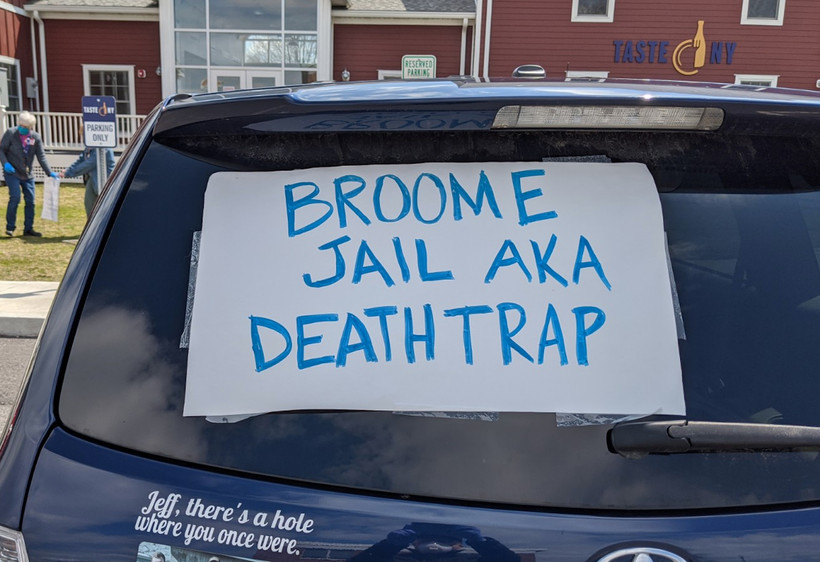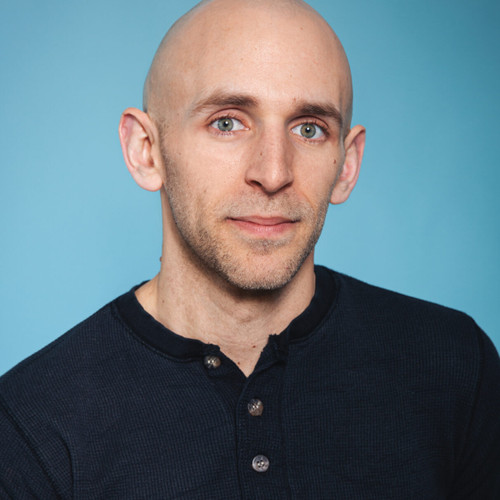In an Upstate Jail, Incarcerated People Struggle to Access Promised Addiction Treatment
In 2019, Broome County promised an addiction treatment program in its jail. Two years later, the program is a “farce,” one advocate said.

This story was published in partnership with Filter, a nonprofit news site covering drug use, drug policy and human rights. Sign up for their newsletter here.
In 2019, the local jail in Broome County, home of Binghamton, was one of several county jails in upstate New York to begin offering medication for opioid use disorder. Attention to the role that treatment in jails and prisons could play in reducing fatal overdoses after release had been growing across the country, and the decision seemed a promising sign that New York could become a national leader on the issue.
But nearly two years later, people currently and recently incarcerated in the Broome County jail say that access has been extremely limited. Drug policy advocates say the inconsistent access to medication demonstrates the need for a statewide mandate to provide incarcerated people with opioid addiction treatment, rather than a patchwork system dependent on the attitudes of local sheriffs and jail administrators.
In February 2021, John*, a 30-year-old resident of Broome County, was reincarcerated in the county jail for violating the conditions of his parole. For the previous four months, he had been taking Suboxone, a medication that helps minimize withdrawal symptoms for people with opioid use disorder.
“Suboxone made it so I could function and I wasn’t anxious and I didn’t want to use other drugs,” John recalled.
But upon being sent to Broome County jail, he said, he lost his access to the medication. He entered opioid withdrawal. He also experienced symptoms of psychosis, which he attributed to loss of access to medication keeping his depression and schizophrenia in check. He was taken to the medical unit, where he experienced a psychotic break, he said, and lost consciousness.
When he woke up, he said, he found himself strapped into a restraint chair, where he was forced to remain for 12 hours while experiencing opioid withdrawal. “They didn’t give me my meds. They didn’t give me nothing,” John said. “It felt horrible.”
About a week later, he said, the jail’s medical staff began giving John medication for his depression and schizophrenia. But they told him that he would not be given Suboxone because his urine had tested positive for marijuana, he said, despite the fact that marijuana use does not prevent successful Suboxone treatment.
John remains incarcerated and unable to access the treatment. “They said no and that’s the rules,” he said. “I am a lot more depressed. I’m coping with it. I have no choice.”
Alexis Pleus, executive director of Truth Pharm, a Broome County-based organization that advocates for the welfare of people who use drugs, said she routinely hears stories like John’s.
“We’ve had so many people contact us and say, ‘My son was on Suboxone and the jail stopped it,’” Pleus said. “I haven't had anyone tell me they had a good process of getting their needs there. It's a farce. Or it's extremely limited.”
John said that while he has heard of other incarcerated people in Broome County’s jail getting Suboxone, most get refused.
The jail claims that its medication for opioid use disorder (MOUD, sometimes known as medication assisted treatment, or MAT) program serves its intended population. “We have an active [MOUD] program in conjunction with the folks at UHS hospital, and we provide medically assisted treatment to the individuals who are indicated in need at the time of admission to the correctional facility,” said Broome County Major Mark Smolinsky, the administrator of the jail.
Jail administration did not respond to inquiries regarding the number of people the jail has approved for MOUD. Alan Wilmarth, the administrative director of behavioral health at UHS hospitals and the administrator of the MOUD program at Broome County’s jail, declined to be interviewed for this article.
Asked about reports of people who say the jail denied them Suboxone or other forms of MOUD, Smolinsky said that use of other drugs could be a reason to deny someone treatment. “Sometimes you could have a case where somebody is also taking maybe a number of other street drugs, whether it’s methamphetamines or K2 or some of the synthetic stuff like that, where it’s then unsafe to continue the Suboxone,” he said.
But one specialist in addiction medicine said that this policy does not accord with best practices for treating opioid use disorder.
“There isn’t really a circumstance or a street drug that is contraindicated with buprenorphine,” said Dr. Justine Waldman, an emergency medicine physician in Ithaca who has prescribed buprenorphine, the generic form of Suboxone, to hundreds of patients. “Every patient who has opioid use disorder should be on a form of medication for opioid use disorder.”
In September 2020, Isaac*, a 25-year-old resident of Broome County, was sentenced to six months in the jail after being convicted of multiple counts of illegally possessing syringes, a misdemeanor offense. Prior to his imprisonment, he had been regularly injecting heroin and buying Suboxone off the street when heroin was unavailable.
As he was being admitted to the jail, Isaac warned staff that he would experience withdrawal. “I told them, ‘I’m going to be sick,’” he said. “They should have put me in medical.” He was not offered medical care and was instead placed in a quarantine cell due to COVID-19 precautions, he said.
Shortly thereafter, Isaac entered opioid withdrawal. “You just have to cry,” he said, describing the experience. “You can be how tough you want; it doesn’t matter. You will cry like a little baby because it hurts.”
Some corrections officers knew that he was going through withdrawal and would periodically check on him, but he was never given medical attention, he said, and was never told that MOUD was available. “I didn’t know that they help you with being sick in jail,” he said.
In the six months that he was in jail, Isaac heard of just one person incarcerated there being approved for Suboxone treatment, he said.
Isaac was released from jail in mid-March. But he has been incarcerated several times, and his sister worries that without reliable access to medication, if he is sent back to the jail again, he could become its next fatality. “If he has to go back after doing drugs again, it gets to the point where you don’t expect him to come out,” she said. “I didn’t expect him to come out this time.”
Broome County’s jail has previously received attention for its poor health conditions. As many as 11 people have died there in the past decade, and last April, the New York Post reported that incarcerated people were being forced to clean the medical unit where COVID-19 patients were being treated without being provided with proper PPE.
Many other jails in New York, and the large majority of its prisons, have no MOUD program at all. But some of the programs that do exist in other jails—including in Albany County, Monroe County, and Onondaga County—have been highly effective, medical professionals and formerly incarcerated people said.
In the Albany County Jail, “as soon as a person identifies that they have an opioid dependence, they are hooked into services,” said Stephanie Lao, the executive director of Catholic Charities AIDS services, which worked with Albany County Sheriff Craig Apple to implement the MOUD program. Since the program began in 2019, Lao has not heard of any cases where people who requested MOUD have not received it, she said.
Both recidivism and fatal overdoses among people released from the Albany County Jail have significantly decreased since the program was instituted, data show. The recidivism rate of participants in the MOUD program stood at 13 percent in November 2019, far lower than the 40 percent overall rate. Lao said that she is not aware of any fatal overdoses occurring among program participants, even as fatal overdoses have risen in Albany overall.
In Monroe County, home of Rochester, Tee-Jay St. John was able to access MOUD while incarcerated in 2019. “I always had this notion that being in jail you would be treated like shit, but honestly, it was a beautiful experience,” St. John said about the program. “The sheriffs were trained properly, knew what we were going through, and they would show compassion.”
No severe withdrawals have occurred in the jail since the MOUD program was instituted in 2019, said Robert Lee, who works closely with incarcerated and recently incarcerated people in the county jail and at a Rochester halfway house.
These programs have succeeded because of the county sheriffs’ dedication to them, both Lao and Lee said. In Albany, Sheriff Apple “recognized the value [of MOUD] specifically around reducing overdoses,” Lao said. “When he made that decision, he told his staff to just make it happen.”
In Broome County, by contrast, Pleus said, Sheriff David Harder has not been committed to the success of the MOUD program. “He doesn’t provide any leadership or make sure that things work well,” she said. “He takes a real hands-off approach to his own jail.” Harder’s office declined to make him available for comment.
State funds to expand incarcerated people’s access to MOUD could soon be made available. A measure in the Senate's budget proposal, also supported by Assembly Speaker Carl Heastie, would allot millions of dollars per year in grants to counties to expand MOUD in jails. The Senate’s budget proposal also includes passage of a currently-pending bill to mandate the provision of MOUD in all jails and prisons statewide. Whether these measures become law will depend on the outcome of negotiations between the legislature and the governor, as the April 1 deadline to enact New York’s 2021-2022 budget approaches.
Advocates say that counties like Broome demonstrate the need for such a comprehensive statewide MOUD mandate, which would reduce the discretion of individual counties and sheriffs and guarantee treatment to all incarcerated people.
A state law mandating MOUD in all New York jails and prisons would create a clear standard under which incarcerated people would be entitled to MOUD, enabling them to sue jails and prisons if needed access is denied, said Jasmine Budnella, drug policy coordinator for grassroots lobbying organization VOCAL-NY.
“When you don’t have a law that is regulating county jails and sheriffs, then we are going to see sheriffs continue to use their power against vulnerable people,” Budnella said.
*Names have been changed to respect sources’ privacy.



